Urban Tourism Field Report: Borough Market, London Analysis Report
VerifiedAdded on 2020/12/09
|15
|5091
|112
Report
AI Summary
This report provides an in-depth analysis of urban tourism, focusing on Borough Market in London. The introduction defines urban tourism, highlighting its economic, social, and cultural significance, and the role of infrastructure and policy. The literature review explores the concept of urban tourism, emphasizing Borough Market as a successful example, detailing its historical context, cultural attributes, and transportation developments. The research methodology is outlined, followed by a presentation of the results, which analyzes the market's attractions, impact on employment, and challenges like overcrowding. The conclusion summarizes the findings, reiterating the importance of balancing growth with local welfare. The report also includes recommendations for increasing urban tourism, emphasizing the need for sustainable practices and the preservation of local culture. References support the analysis, providing a comprehensive overview of urban tourism and Borough Market's place within it. The report aims to analyze the importance and impact of urban tourism, and to provide recommendations on how urban tourism can be increased.

Urban Tourism Field Report
Paraphrase This Document
Need a fresh take? Get an instant paraphrase of this document with our AI Paraphraser
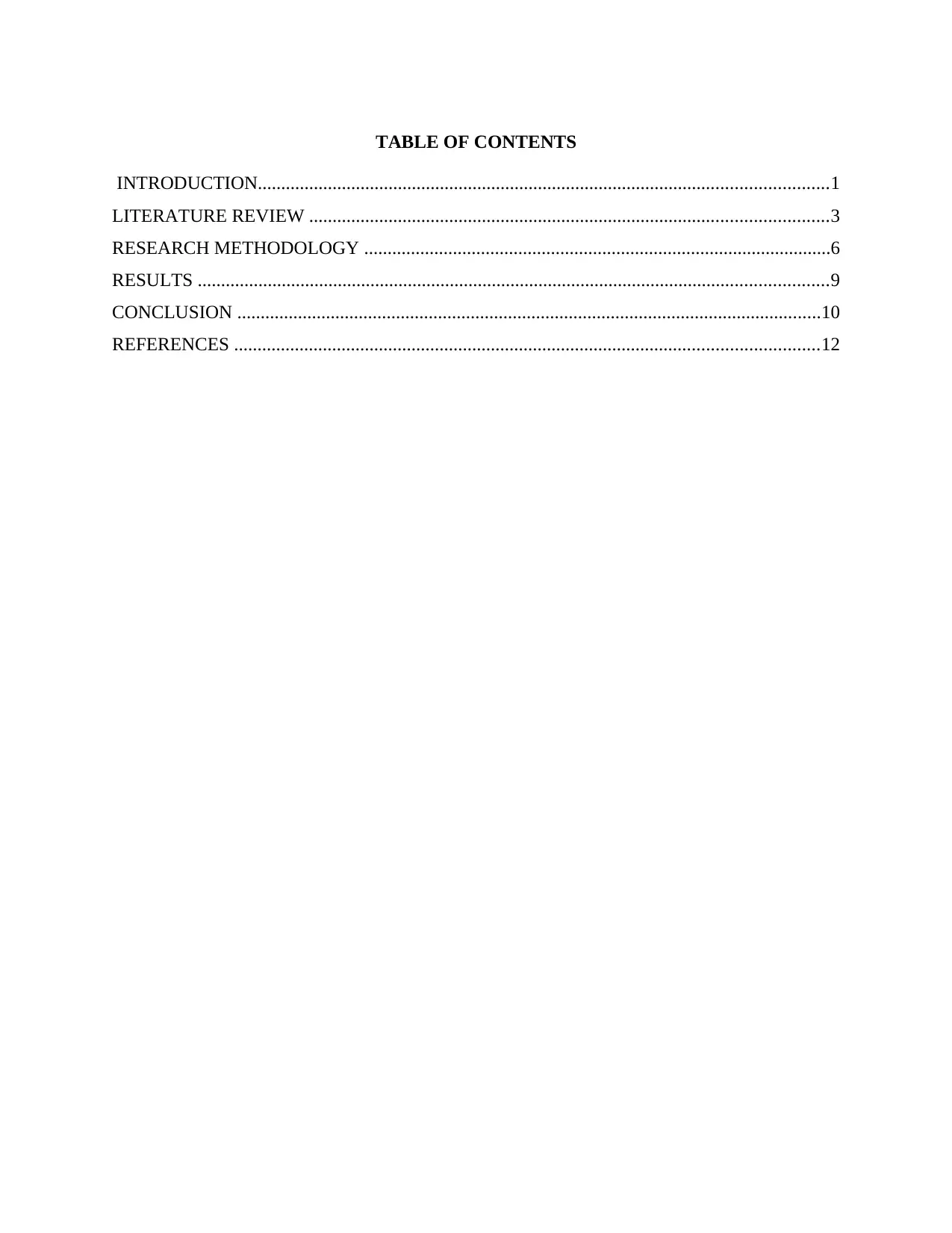
TABLE OF CONTENTS
INTRODUCTION..........................................................................................................................1
LITERATURE REVIEW ...............................................................................................................3
RESEARCH METHODOLOGY ....................................................................................................6
RESULTS .......................................................................................................................................9
CONCLUSION .............................................................................................................................10
REFERENCES .............................................................................................................................12
INTRODUCTION..........................................................................................................................1
LITERATURE REVIEW ...............................................................................................................3
RESEARCH METHODOLOGY ....................................................................................................6
RESULTS .......................................................................................................................................9
CONCLUSION .............................................................................................................................10
REFERENCES .............................................................................................................................12
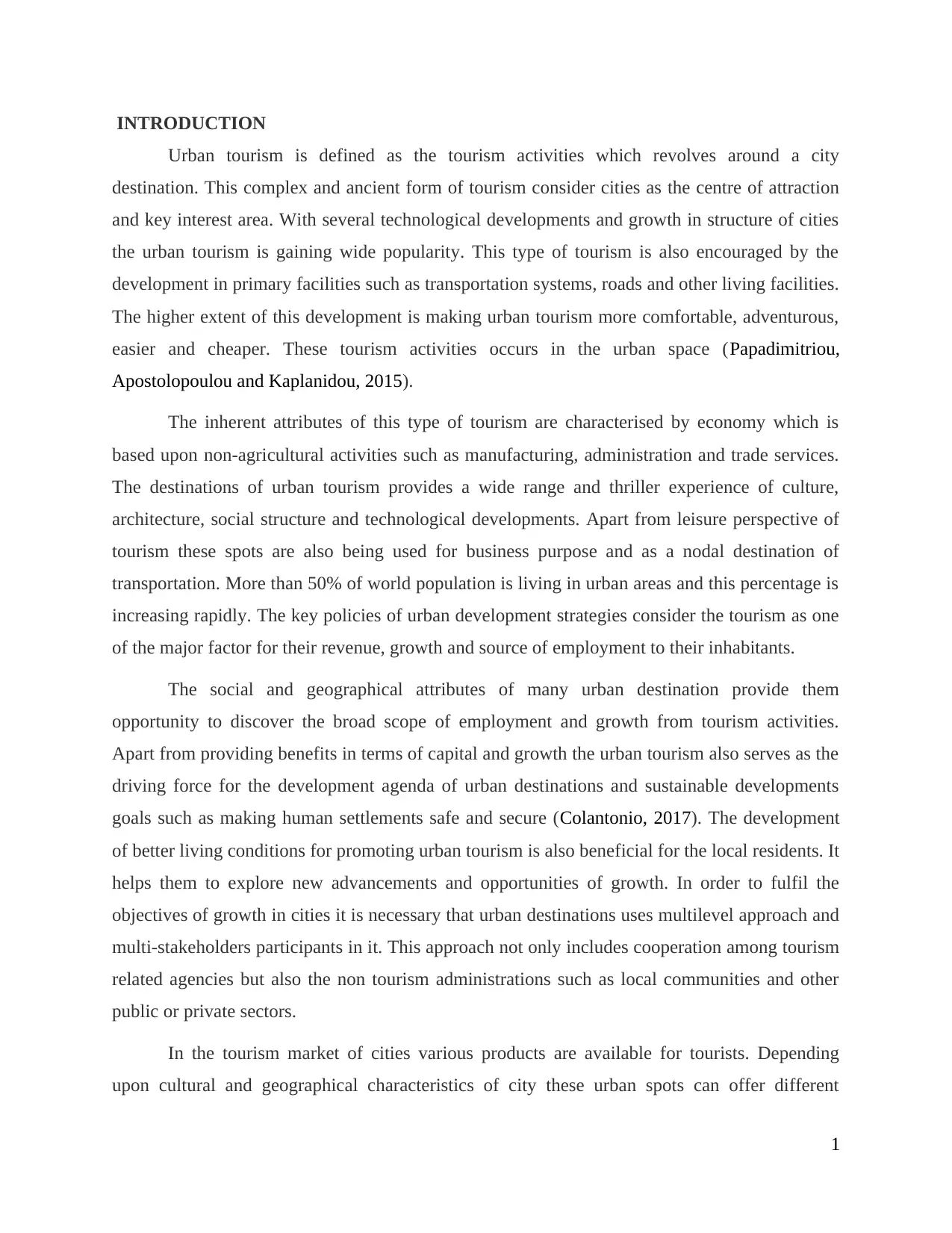
INTRODUCTION
Urban tourism is defined as the tourism activities which revolves around a city
destination. This complex and ancient form of tourism consider cities as the centre of attraction
and key interest area. With several technological developments and growth in structure of cities
the urban tourism is gaining wide popularity. This type of tourism is also encouraged by the
development in primary facilities such as transportation systems, roads and other living facilities.
The higher extent of this development is making urban tourism more comfortable, adventurous,
easier and cheaper. These tourism activities occurs in the urban space (Papadimitriou,
Apostolopoulou and Kaplanidou, 2015).
The inherent attributes of this type of tourism are characterised by economy which is
based upon non-agricultural activities such as manufacturing, administration and trade services.
The destinations of urban tourism provides a wide range and thriller experience of culture,
architecture, social structure and technological developments. Apart from leisure perspective of
tourism these spots are also being used for business purpose and as a nodal destination of
transportation. More than 50% of world population is living in urban areas and this percentage is
increasing rapidly. The key policies of urban development strategies consider the tourism as one
of the major factor for their revenue, growth and source of employment to their inhabitants.
The social and geographical attributes of many urban destination provide them
opportunity to discover the broad scope of employment and growth from tourism activities.
Apart from providing benefits in terms of capital and growth the urban tourism also serves as the
driving force for the development agenda of urban destinations and sustainable developments
goals such as making human settlements safe and secure (Colantonio, 2017). The development
of better living conditions for promoting urban tourism is also beneficial for the local residents. It
helps them to explore new advancements and opportunities of growth. In order to fulfil the
objectives of growth in cities it is necessary that urban destinations uses multilevel approach and
multi-stakeholders participants in it. This approach not only includes cooperation among tourism
related agencies but also the non tourism administrations such as local communities and other
public or private sectors.
In the tourism market of cities various products are available for tourists. Depending
upon cultural and geographical characteristics of city these urban spots can offer different
1
Urban tourism is defined as the tourism activities which revolves around a city
destination. This complex and ancient form of tourism consider cities as the centre of attraction
and key interest area. With several technological developments and growth in structure of cities
the urban tourism is gaining wide popularity. This type of tourism is also encouraged by the
development in primary facilities such as transportation systems, roads and other living facilities.
The higher extent of this development is making urban tourism more comfortable, adventurous,
easier and cheaper. These tourism activities occurs in the urban space (Papadimitriou,
Apostolopoulou and Kaplanidou, 2015).
The inherent attributes of this type of tourism are characterised by economy which is
based upon non-agricultural activities such as manufacturing, administration and trade services.
The destinations of urban tourism provides a wide range and thriller experience of culture,
architecture, social structure and technological developments. Apart from leisure perspective of
tourism these spots are also being used for business purpose and as a nodal destination of
transportation. More than 50% of world population is living in urban areas and this percentage is
increasing rapidly. The key policies of urban development strategies consider the tourism as one
of the major factor for their revenue, growth and source of employment to their inhabitants.
The social and geographical attributes of many urban destination provide them
opportunity to discover the broad scope of employment and growth from tourism activities.
Apart from providing benefits in terms of capital and growth the urban tourism also serves as the
driving force for the development agenda of urban destinations and sustainable developments
goals such as making human settlements safe and secure (Colantonio, 2017). The development
of better living conditions for promoting urban tourism is also beneficial for the local residents. It
helps them to explore new advancements and opportunities of growth. In order to fulfil the
objectives of growth in cities it is necessary that urban destinations uses multilevel approach and
multi-stakeholders participants in it. This approach not only includes cooperation among tourism
related agencies but also the non tourism administrations such as local communities and other
public or private sectors.
In the tourism market of cities various products are available for tourists. Depending
upon cultural and geographical characteristics of city these urban spots can offer different
1
⊘ This is a preview!⊘
Do you want full access?
Subscribe today to unlock all pages.

Trusted by 1+ million students worldwide
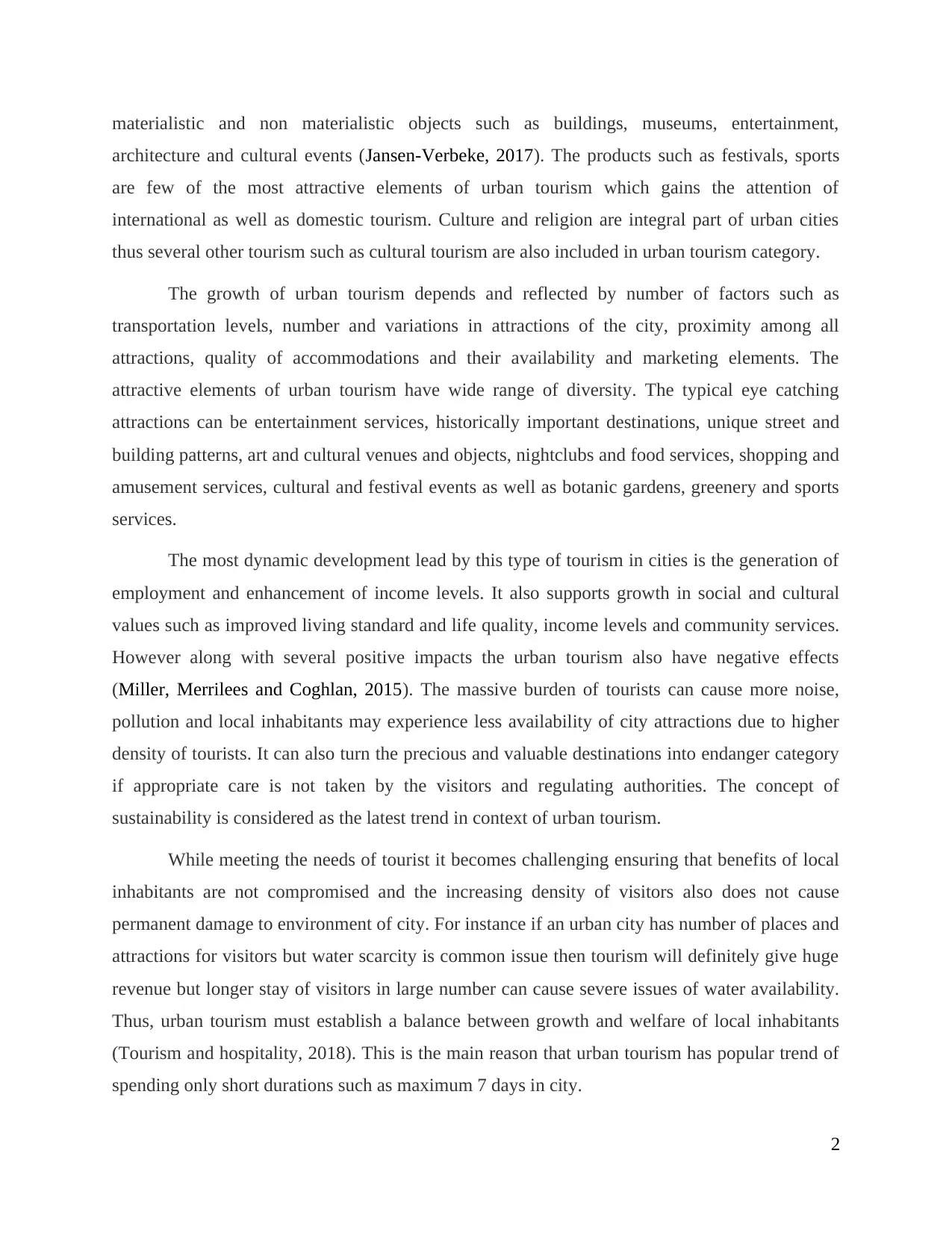
materialistic and non materialistic objects such as buildings, museums, entertainment,
architecture and cultural events (Jansen-Verbeke, 2017). The products such as festivals, sports
are few of the most attractive elements of urban tourism which gains the attention of
international as well as domestic tourism. Culture and religion are integral part of urban cities
thus several other tourism such as cultural tourism are also included in urban tourism category.
The growth of urban tourism depends and reflected by number of factors such as
transportation levels, number and variations in attractions of the city, proximity among all
attractions, quality of accommodations and their availability and marketing elements. The
attractive elements of urban tourism have wide range of diversity. The typical eye catching
attractions can be entertainment services, historically important destinations, unique street and
building patterns, art and cultural venues and objects, nightclubs and food services, shopping and
amusement services, cultural and festival events as well as botanic gardens, greenery and sports
services.
The most dynamic development lead by this type of tourism in cities is the generation of
employment and enhancement of income levels. It also supports growth in social and cultural
values such as improved living standard and life quality, income levels and community services.
However along with several positive impacts the urban tourism also have negative effects
(Miller, Merrilees and Coghlan, 2015). The massive burden of tourists can cause more noise,
pollution and local inhabitants may experience less availability of city attractions due to higher
density of tourists. It can also turn the precious and valuable destinations into endanger category
if appropriate care is not taken by the visitors and regulating authorities. The concept of
sustainability is considered as the latest trend in context of urban tourism.
While meeting the needs of tourist it becomes challenging ensuring that benefits of local
inhabitants are not compromised and the increasing density of visitors also does not cause
permanent damage to environment of city. For instance if an urban city has number of places and
attractions for visitors but water scarcity is common issue then tourism will definitely give huge
revenue but longer stay of visitors in large number can cause severe issues of water availability.
Thus, urban tourism must establish a balance between growth and welfare of local inhabitants
(Tourism and hospitality, 2018). This is the main reason that urban tourism has popular trend of
spending only short durations such as maximum 7 days in city.
2
architecture and cultural events (Jansen-Verbeke, 2017). The products such as festivals, sports
are few of the most attractive elements of urban tourism which gains the attention of
international as well as domestic tourism. Culture and religion are integral part of urban cities
thus several other tourism such as cultural tourism are also included in urban tourism category.
The growth of urban tourism depends and reflected by number of factors such as
transportation levels, number and variations in attractions of the city, proximity among all
attractions, quality of accommodations and their availability and marketing elements. The
attractive elements of urban tourism have wide range of diversity. The typical eye catching
attractions can be entertainment services, historically important destinations, unique street and
building patterns, art and cultural venues and objects, nightclubs and food services, shopping and
amusement services, cultural and festival events as well as botanic gardens, greenery and sports
services.
The most dynamic development lead by this type of tourism in cities is the generation of
employment and enhancement of income levels. It also supports growth in social and cultural
values such as improved living standard and life quality, income levels and community services.
However along with several positive impacts the urban tourism also have negative effects
(Miller, Merrilees and Coghlan, 2015). The massive burden of tourists can cause more noise,
pollution and local inhabitants may experience less availability of city attractions due to higher
density of tourists. It can also turn the precious and valuable destinations into endanger category
if appropriate care is not taken by the visitors and regulating authorities. The concept of
sustainability is considered as the latest trend in context of urban tourism.
While meeting the needs of tourist it becomes challenging ensuring that benefits of local
inhabitants are not compromised and the increasing density of visitors also does not cause
permanent damage to environment of city. For instance if an urban city has number of places and
attractions for visitors but water scarcity is common issue then tourism will definitely give huge
revenue but longer stay of visitors in large number can cause severe issues of water availability.
Thus, urban tourism must establish a balance between growth and welfare of local inhabitants
(Tourism and hospitality, 2018). This is the main reason that urban tourism has popular trend of
spending only short durations such as maximum 7 days in city.
2
Paraphrase This Document
Need a fresh take? Get an instant paraphrase of this document with our AI Paraphraser
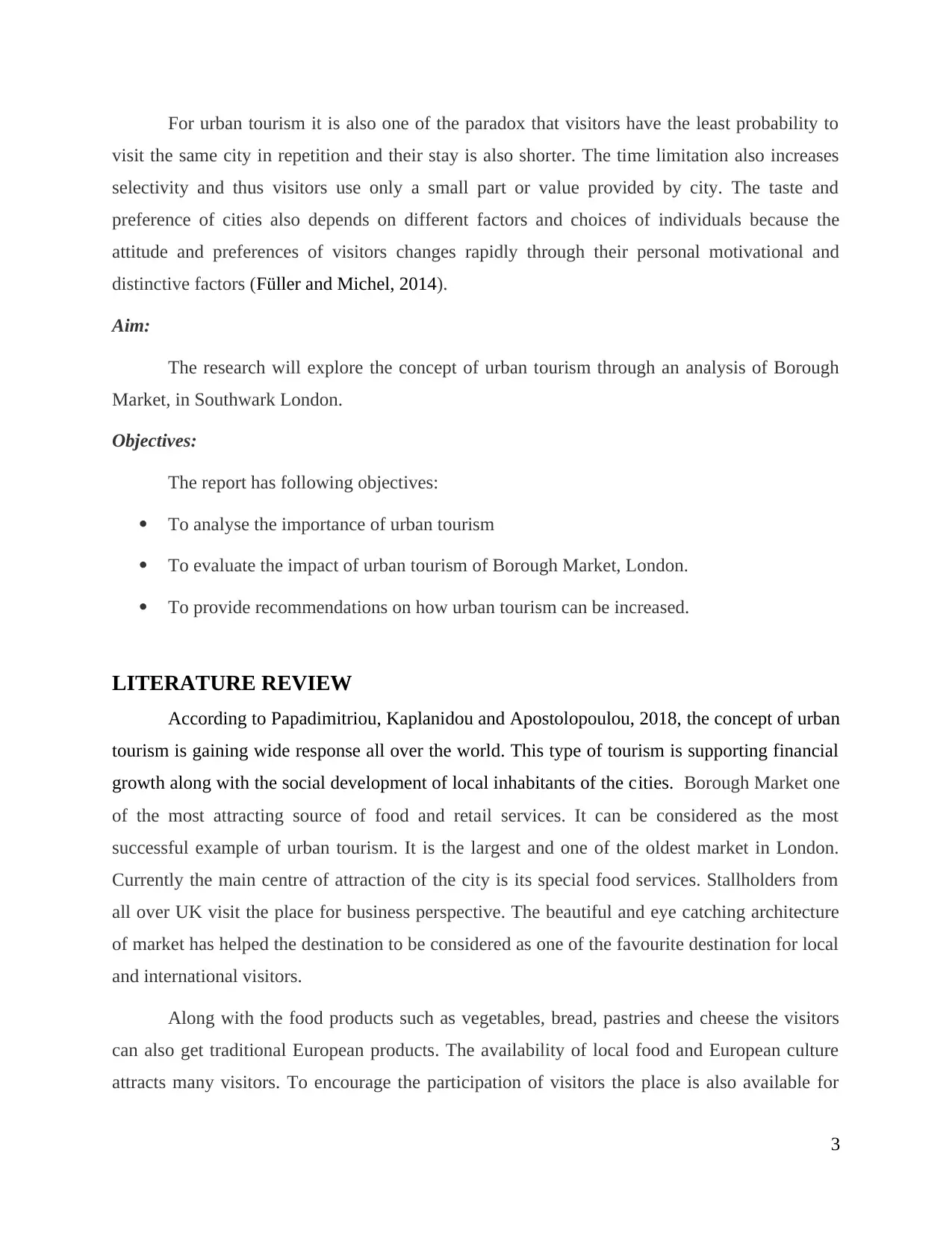
For urban tourism it is also one of the paradox that visitors have the least probability to
visit the same city in repetition and their stay is also shorter. The time limitation also increases
selectivity and thus visitors use only a small part or value provided by city. The taste and
preference of cities also depends on different factors and choices of individuals because the
attitude and preferences of visitors changes rapidly through their personal motivational and
distinctive factors (Füller and Michel, 2014).
Aim:
The research will explore the concept of urban tourism through an analysis of Borough
Market, in Southwark London.
Objectives:
The report has following objectives:
To analyse the importance of urban tourism
To evaluate the impact of urban tourism of Borough Market, London.
To provide recommendations on how urban tourism can be increased.
LITERATURE REVIEW
According to Papadimitriou, Kaplanidou and Apostolopoulou, 2018, the concept of urban
tourism is gaining wide response all over the world. This type of tourism is supporting financial
growth along with the social development of local inhabitants of the cities. Borough Market one
of the most attracting source of food and retail services. It can be considered as the most
successful example of urban tourism. It is the largest and one of the oldest market in London.
Currently the main centre of attraction of the city is its special food services. Stallholders from
all over UK visit the place for business perspective. The beautiful and eye catching architecture
of market has helped the destination to be considered as one of the favourite destination for local
and international visitors.
Along with the food products such as vegetables, bread, pastries and cheese the visitors
can also get traditional European products. The availability of local food and European culture
attracts many visitors. To encourage the participation of visitors the place is also available for
3
visit the same city in repetition and their stay is also shorter. The time limitation also increases
selectivity and thus visitors use only a small part or value provided by city. The taste and
preference of cities also depends on different factors and choices of individuals because the
attitude and preferences of visitors changes rapidly through their personal motivational and
distinctive factors (Füller and Michel, 2014).
Aim:
The research will explore the concept of urban tourism through an analysis of Borough
Market, in Southwark London.
Objectives:
The report has following objectives:
To analyse the importance of urban tourism
To evaluate the impact of urban tourism of Borough Market, London.
To provide recommendations on how urban tourism can be increased.
LITERATURE REVIEW
According to Papadimitriou, Kaplanidou and Apostolopoulou, 2018, the concept of urban
tourism is gaining wide response all over the world. This type of tourism is supporting financial
growth along with the social development of local inhabitants of the cities. Borough Market one
of the most attracting source of food and retail services. It can be considered as the most
successful example of urban tourism. It is the largest and one of the oldest market in London.
Currently the main centre of attraction of the city is its special food services. Stallholders from
all over UK visit the place for business perspective. The beautiful and eye catching architecture
of market has helped the destination to be considered as one of the favourite destination for local
and international visitors.
Along with the food products such as vegetables, bread, pastries and cheese the visitors
can also get traditional European products. The availability of local food and European culture
attracts many visitors. To encourage the participation of visitors the place is also available for
3
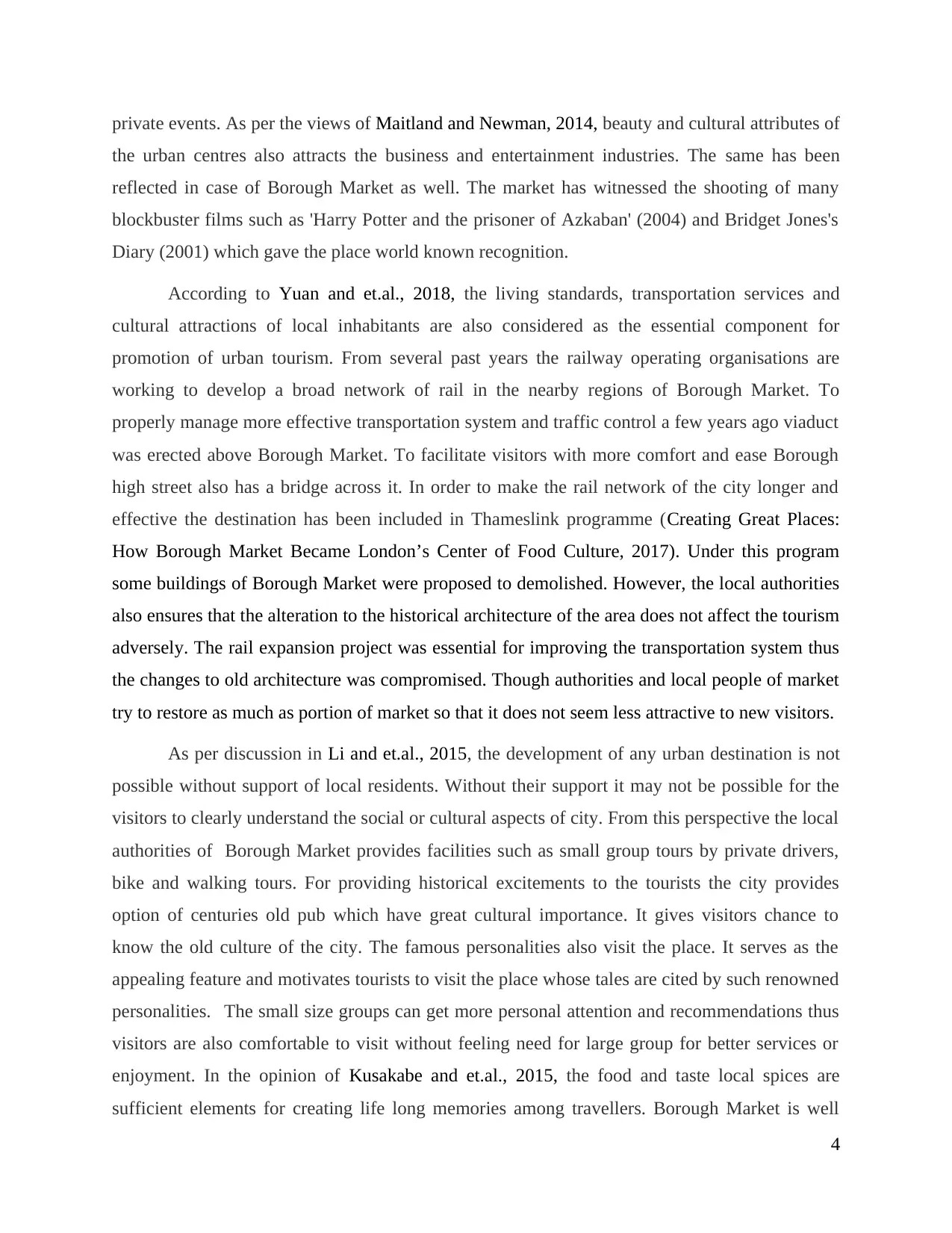
private events. As per the views of Maitland and Newman, 2014, beauty and cultural attributes of
the urban centres also attracts the business and entertainment industries. The same has been
reflected in case of Borough Market as well. The market has witnessed the shooting of many
blockbuster films such as 'Harry Potter and the prisoner of Azkaban' (2004) and Bridget Jones's
Diary (2001) which gave the place world known recognition.
According to Yuan and et.al., 2018, the living standards, transportation services and
cultural attractions of local inhabitants are also considered as the essential component for
promotion of urban tourism. From several past years the railway operating organisations are
working to develop a broad network of rail in the nearby regions of Borough Market. To
properly manage more effective transportation system and traffic control a few years ago viaduct
was erected above Borough Market. To facilitate visitors with more comfort and ease Borough
high street also has a bridge across it. In order to make the rail network of the city longer and
effective the destination has been included in Thameslink programme (Creating Great Places:
How Borough Market Became London’s Center of Food Culture, 2017). Under this program
some buildings of Borough Market were proposed to demolished. However, the local authorities
also ensures that the alteration to the historical architecture of the area does not affect the tourism
adversely. The rail expansion project was essential for improving the transportation system thus
the changes to old architecture was compromised. Though authorities and local people of market
try to restore as much as portion of market so that it does not seem less attractive to new visitors.
As per discussion in Li and et.al., 2015, the development of any urban destination is not
possible without support of local residents. Without their support it may not be possible for the
visitors to clearly understand the social or cultural aspects of city. From this perspective the local
authorities of Borough Market provides facilities such as small group tours by private drivers,
bike and walking tours. For providing historical excitements to the tourists the city provides
option of centuries old pub which have great cultural importance. It gives visitors chance to
know the old culture of the city. The famous personalities also visit the place. It serves as the
appealing feature and motivates tourists to visit the place whose tales are cited by such renowned
personalities. The small size groups can get more personal attention and recommendations thus
visitors are also comfortable to visit without feeling need for large group for better services or
enjoyment. In the opinion of Kusakabe and et.al., 2015, the food and taste local spices are
sufficient elements for creating life long memories among travellers. Borough Market is well
4
the urban centres also attracts the business and entertainment industries. The same has been
reflected in case of Borough Market as well. The market has witnessed the shooting of many
blockbuster films such as 'Harry Potter and the prisoner of Azkaban' (2004) and Bridget Jones's
Diary (2001) which gave the place world known recognition.
According to Yuan and et.al., 2018, the living standards, transportation services and
cultural attractions of local inhabitants are also considered as the essential component for
promotion of urban tourism. From several past years the railway operating organisations are
working to develop a broad network of rail in the nearby regions of Borough Market. To
properly manage more effective transportation system and traffic control a few years ago viaduct
was erected above Borough Market. To facilitate visitors with more comfort and ease Borough
high street also has a bridge across it. In order to make the rail network of the city longer and
effective the destination has been included in Thameslink programme (Creating Great Places:
How Borough Market Became London’s Center of Food Culture, 2017). Under this program
some buildings of Borough Market were proposed to demolished. However, the local authorities
also ensures that the alteration to the historical architecture of the area does not affect the tourism
adversely. The rail expansion project was essential for improving the transportation system thus
the changes to old architecture was compromised. Though authorities and local people of market
try to restore as much as portion of market so that it does not seem less attractive to new visitors.
As per discussion in Li and et.al., 2015, the development of any urban destination is not
possible without support of local residents. Without their support it may not be possible for the
visitors to clearly understand the social or cultural aspects of city. From this perspective the local
authorities of Borough Market provides facilities such as small group tours by private drivers,
bike and walking tours. For providing historical excitements to the tourists the city provides
option of centuries old pub which have great cultural importance. It gives visitors chance to
know the old culture of the city. The famous personalities also visit the place. It serves as the
appealing feature and motivates tourists to visit the place whose tales are cited by such renowned
personalities. The small size groups can get more personal attention and recommendations thus
visitors are also comfortable to visit without feeling need for large group for better services or
enjoyment. In the opinion of Kusakabe and et.al., 2015, the food and taste local spices are
sufficient elements for creating life long memories among travellers. Borough Market is well
4
⊘ This is a preview!⊘
Do you want full access?
Subscribe today to unlock all pages.

Trusted by 1+ million students worldwide

known destination where one can get timeless recipes as well as new creative cuisines. To
explore the taste of each food speciality the visitors prefers to take walking tour for this segment
of their journey. Along with the delicious food the visitors can also enjoy their tour by moving to
local pubs, artisan stores, stalls and bakeries in the market.
The visit to market also enable tourists to explore the famous foods of city and British
culture. According to Rabbiosi, 2015, the popularity and critical success criteria of an urban
tourist destination lie in the fact that during visit the visitor does not miss their native place or
any other thing ranging from food, enjoyment and transportation. Rather, they must appreciate
and lost into the unique offerings of the destination. The same matter of fact is also observed in
Borough Market. Along with the traditional content of British culture the market also has
vendors serving international delicacies such as Indian street foods, handmade chocolates and
raclette. The Thames river, London bridge are extreme paradise to Borough Market (London’s
best (and best-known) food market is a bustling, beloved dining destination., 2018). The visit can
give deep understanding of the culture, beauty and history of the city. This urban tourism
destination provides the best accommodation services. The easy transport services with vast
cultural and nature guide makes the destination as preferred zone for stay, shop, eat and site
seeing. In comparison to other nearby markets such as Druid street and Maltby. However, the
taste from different corners of world can be found within this single destination. Thus, this urban
destination has proved to be successful tourism place.
As most of the urban tourism places suffers from pitfalls, the Borough Market is also not
the exceptional one. The market is extremely engaged and is full of chaos. The massive rush
even during normal days of year can give the idea of its popularity. Being a hotspot of the city
the location is occupied with several numbers of visitors which have more concern for taking
picture of the city instead of buying objects. It makes the area extremely engaged and local
inhabitants experiences some difficulties. For instance it becomes a challenging task for an
inhabitant of the place to reach another end of market by crossing huge rush of the visitors. The
overwhelming nature of crowd also promote the extensive use of natural resources.
According to Füller and Michel, 2014, the globalisation and digital technology has given
a new level to tourism industry. However, the environmental and certain social challenges are
still crucial barriers for the tourists. For example the security and civil circumstances can act as
5
explore the taste of each food speciality the visitors prefers to take walking tour for this segment
of their journey. Along with the delicious food the visitors can also enjoy their tour by moving to
local pubs, artisan stores, stalls and bakeries in the market.
The visit to market also enable tourists to explore the famous foods of city and British
culture. According to Rabbiosi, 2015, the popularity and critical success criteria of an urban
tourist destination lie in the fact that during visit the visitor does not miss their native place or
any other thing ranging from food, enjoyment and transportation. Rather, they must appreciate
and lost into the unique offerings of the destination. The same matter of fact is also observed in
Borough Market. Along with the traditional content of British culture the market also has
vendors serving international delicacies such as Indian street foods, handmade chocolates and
raclette. The Thames river, London bridge are extreme paradise to Borough Market (London’s
best (and best-known) food market is a bustling, beloved dining destination., 2018). The visit can
give deep understanding of the culture, beauty and history of the city. This urban tourism
destination provides the best accommodation services. The easy transport services with vast
cultural and nature guide makes the destination as preferred zone for stay, shop, eat and site
seeing. In comparison to other nearby markets such as Druid street and Maltby. However, the
taste from different corners of world can be found within this single destination. Thus, this urban
destination has proved to be successful tourism place.
As most of the urban tourism places suffers from pitfalls, the Borough Market is also not
the exceptional one. The market is extremely engaged and is full of chaos. The massive rush
even during normal days of year can give the idea of its popularity. Being a hotspot of the city
the location is occupied with several numbers of visitors which have more concern for taking
picture of the city instead of buying objects. It makes the area extremely engaged and local
inhabitants experiences some difficulties. For instance it becomes a challenging task for an
inhabitant of the place to reach another end of market by crossing huge rush of the visitors. The
overwhelming nature of crowd also promote the extensive use of natural resources.
According to Füller and Michel, 2014, the globalisation and digital technology has given
a new level to tourism industry. However, the environmental and certain social challenges are
still crucial barriers for the tourists. For example the security and civil circumstances can act as
5
Paraphrase This Document
Need a fresh take? Get an instant paraphrase of this document with our AI Paraphraser
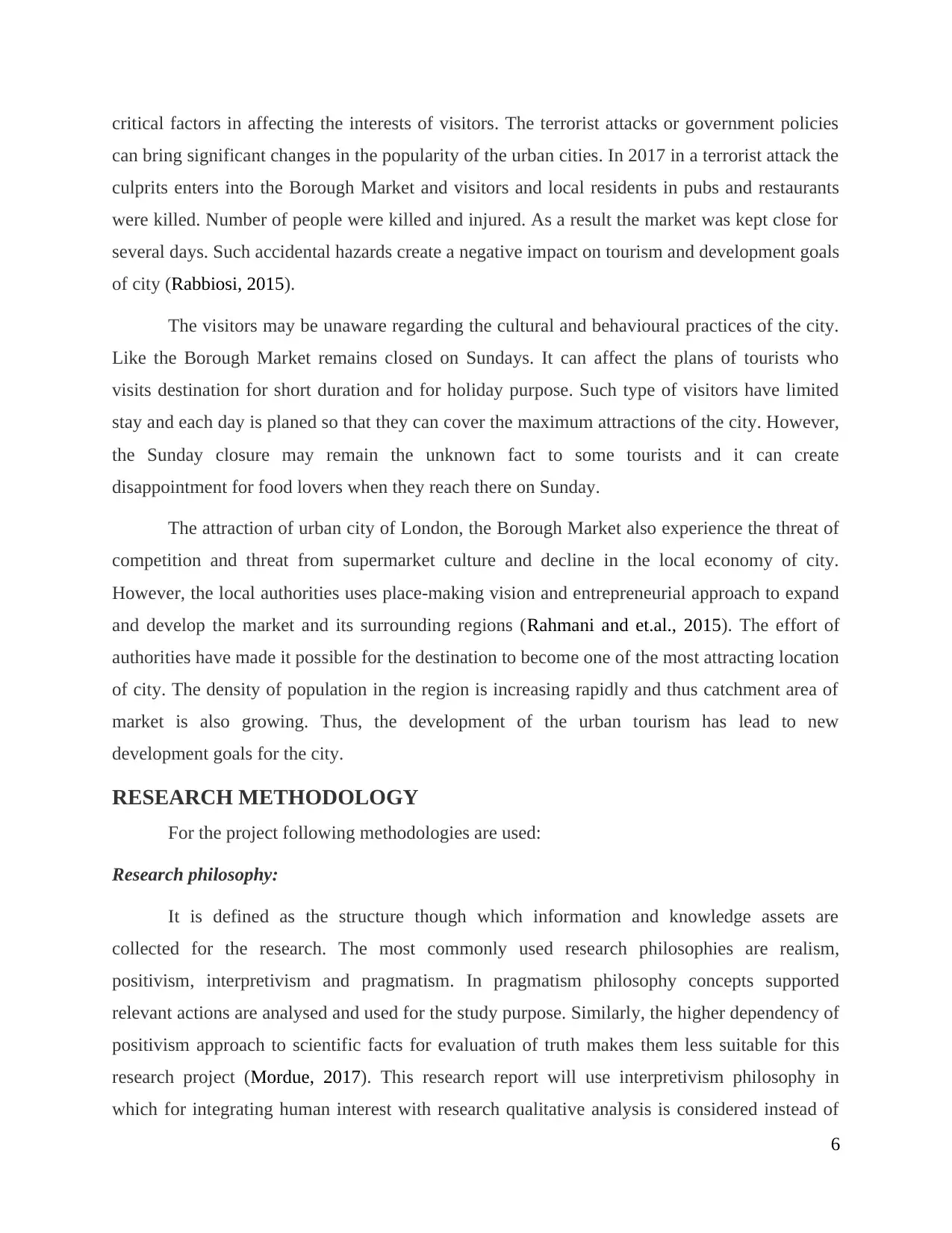
critical factors in affecting the interests of visitors. The terrorist attacks or government policies
can bring significant changes in the popularity of the urban cities. In 2017 in a terrorist attack the
culprits enters into the Borough Market and visitors and local residents in pubs and restaurants
were killed. Number of people were killed and injured. As a result the market was kept close for
several days. Such accidental hazards create a negative impact on tourism and development goals
of city (Rabbiosi, 2015).
The visitors may be unaware regarding the cultural and behavioural practices of the city.
Like the Borough Market remains closed on Sundays. It can affect the plans of tourists who
visits destination for short duration and for holiday purpose. Such type of visitors have limited
stay and each day is planed so that they can cover the maximum attractions of the city. However,
the Sunday closure may remain the unknown fact to some tourists and it can create
disappointment for food lovers when they reach there on Sunday.
The attraction of urban city of London, the Borough Market also experience the threat of
competition and threat from supermarket culture and decline in the local economy of city.
However, the local authorities uses place-making vision and entrepreneurial approach to expand
and develop the market and its surrounding regions (Rahmani and et.al., 2015). The effort of
authorities have made it possible for the destination to become one of the most attracting location
of city. The density of population in the region is increasing rapidly and thus catchment area of
market is also growing. Thus, the development of the urban tourism has lead to new
development goals for the city.
RESEARCH METHODOLOGY
For the project following methodologies are used:
Research philosophy:
It is defined as the structure though which information and knowledge assets are
collected for the research. The most commonly used research philosophies are realism,
positivism, interpretivism and pragmatism. In pragmatism philosophy concepts supported
relevant actions are analysed and used for the study purpose. Similarly, the higher dependency of
positivism approach to scientific facts for evaluation of truth makes them less suitable for this
research project (Mordue, 2017). This research report will use interpretivism philosophy in
which for integrating human interest with research qualitative analysis is considered instead of
6
can bring significant changes in the popularity of the urban cities. In 2017 in a terrorist attack the
culprits enters into the Borough Market and visitors and local residents in pubs and restaurants
were killed. Number of people were killed and injured. As a result the market was kept close for
several days. Such accidental hazards create a negative impact on tourism and development goals
of city (Rabbiosi, 2015).
The visitors may be unaware regarding the cultural and behavioural practices of the city.
Like the Borough Market remains closed on Sundays. It can affect the plans of tourists who
visits destination for short duration and for holiday purpose. Such type of visitors have limited
stay and each day is planed so that they can cover the maximum attractions of the city. However,
the Sunday closure may remain the unknown fact to some tourists and it can create
disappointment for food lovers when they reach there on Sunday.
The attraction of urban city of London, the Borough Market also experience the threat of
competition and threat from supermarket culture and decline in the local economy of city.
However, the local authorities uses place-making vision and entrepreneurial approach to expand
and develop the market and its surrounding regions (Rahmani and et.al., 2015). The effort of
authorities have made it possible for the destination to become one of the most attracting location
of city. The density of population in the region is increasing rapidly and thus catchment area of
market is also growing. Thus, the development of the urban tourism has lead to new
development goals for the city.
RESEARCH METHODOLOGY
For the project following methodologies are used:
Research philosophy:
It is defined as the structure though which information and knowledge assets are
collected for the research. The most commonly used research philosophies are realism,
positivism, interpretivism and pragmatism. In pragmatism philosophy concepts supported
relevant actions are analysed and used for the study purpose. Similarly, the higher dependency of
positivism approach to scientific facts for evaluation of truth makes them less suitable for this
research project (Mordue, 2017). This research report will use interpretivism philosophy in
which for integrating human interest with research qualitative analysis is considered instead of
6
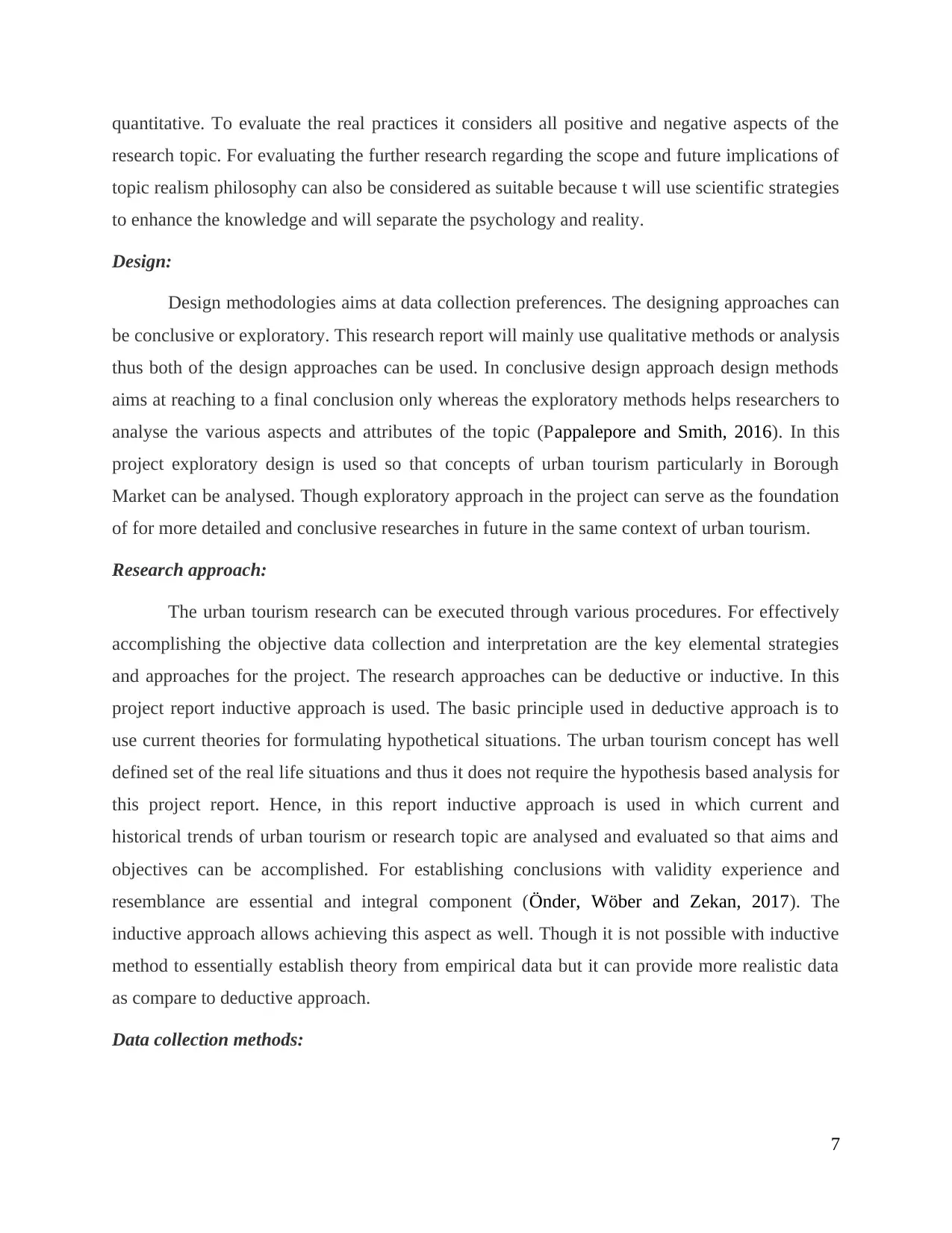
quantitative. To evaluate the real practices it considers all positive and negative aspects of the
research topic. For evaluating the further research regarding the scope and future implications of
topic realism philosophy can also be considered as suitable because t will use scientific strategies
to enhance the knowledge and will separate the psychology and reality.
Design:
Design methodologies aims at data collection preferences. The designing approaches can
be conclusive or exploratory. This research report will mainly use qualitative methods or analysis
thus both of the design approaches can be used. In conclusive design approach design methods
aims at reaching to a final conclusion only whereas the exploratory methods helps researchers to
analyse the various aspects and attributes of the topic (Pappalepore and Smith, 2016). In this
project exploratory design is used so that concepts of urban tourism particularly in Borough
Market can be analysed. Though exploratory approach in the project can serve as the foundation
of for more detailed and conclusive researches in future in the same context of urban tourism.
Research approach:
The urban tourism research can be executed through various procedures. For effectively
accomplishing the objective data collection and interpretation are the key elemental strategies
and approaches for the project. The research approaches can be deductive or inductive. In this
project report inductive approach is used. The basic principle used in deductive approach is to
use current theories for formulating hypothetical situations. The urban tourism concept has well
defined set of the real life situations and thus it does not require the hypothesis based analysis for
this project report. Hence, in this report inductive approach is used in which current and
historical trends of urban tourism or research topic are analysed and evaluated so that aims and
objectives can be accomplished. For establishing conclusions with validity experience and
resemblance are essential and integral component (Önder, Wöber and Zekan, 2017). The
inductive approach allows achieving this aspect as well. Though it is not possible with inductive
method to essentially establish theory from empirical data but it can provide more realistic data
as compare to deductive approach.
Data collection methods:
7
research topic. For evaluating the further research regarding the scope and future implications of
topic realism philosophy can also be considered as suitable because t will use scientific strategies
to enhance the knowledge and will separate the psychology and reality.
Design:
Design methodologies aims at data collection preferences. The designing approaches can
be conclusive or exploratory. This research report will mainly use qualitative methods or analysis
thus both of the design approaches can be used. In conclusive design approach design methods
aims at reaching to a final conclusion only whereas the exploratory methods helps researchers to
analyse the various aspects and attributes of the topic (Pappalepore and Smith, 2016). In this
project exploratory design is used so that concepts of urban tourism particularly in Borough
Market can be analysed. Though exploratory approach in the project can serve as the foundation
of for more detailed and conclusive researches in future in the same context of urban tourism.
Research approach:
The urban tourism research can be executed through various procedures. For effectively
accomplishing the objective data collection and interpretation are the key elemental strategies
and approaches for the project. The research approaches can be deductive or inductive. In this
project report inductive approach is used. The basic principle used in deductive approach is to
use current theories for formulating hypothetical situations. The urban tourism concept has well
defined set of the real life situations and thus it does not require the hypothesis based analysis for
this project report. Hence, in this report inductive approach is used in which current and
historical trends of urban tourism or research topic are analysed and evaluated so that aims and
objectives can be accomplished. For establishing conclusions with validity experience and
resemblance are essential and integral component (Önder, Wöber and Zekan, 2017). The
inductive approach allows achieving this aspect as well. Though it is not possible with inductive
method to essentially establish theory from empirical data but it can provide more realistic data
as compare to deductive approach.
Data collection methods:
7
⊘ This is a preview!⊘
Do you want full access?
Subscribe today to unlock all pages.

Trusted by 1+ million students worldwide

The data analysis is the key prospect of any research method. The data must be collected
with suitable considerations so that they can help to evaluate the desired outcomes. Primary and
secondary data collection methods are most commonly used methods in research projects. The
primary data is defined as the data or information which is collected through research, survey,
questionnaires and is not the work of other authors. On the other hand the data which is
published in various sources such as websites, books and journals is considered as the secondary
data collection methods. Usually this approach gives more authenticity and validity to the
research work (Füller and Michel, 2014). The primary data collection methods can include
qualitative as well as quantitative tools. The qualitative tools are characterised by non-
mathematical operational data such as choices, feelings, emotions and preferences while
quantitative data is purely based upon mathematical calculations. In this project report both
primary and secondary data collection methods are used. However, the quantitative primary data
is not selected for the report because the topic and its scope is largely influenced by the
qualitative attributes.
Ethical considerations:
The ethics are considered as the desired aspects in all types of researches. The ethical
approach during research not only makes the outputs more valid and effective but also makes the
project more validate and accurate (Rogerson and Rogerson, 2014). The research has used
secondary data sources as well thus it is essential that these secondary sources are acknowledged
in the project. The different perspective on urban tourism are also influenced by different people.
Thus, during research it is assured that none of the participant were caused harm and their
opinions were taken only after their consent. The identity and confidentiality of the participants
is also protected.
The conversation with the audience participating in research was transparent and clear so
that participants do not feel uncomfortable. Before communication all the participants must be
informed regarding the scope and purpose of the project so that they have complete awareness
that why their opinions are essential and for what purpose it can be used. During research
accomplishment any kind of misleading facts must not be presented neither in report nor to
participants. It is the responsibility and ethical duty of the researcher to ensure that ideologies
and perspective of audience and participants are presented originally without giving them a
8
with suitable considerations so that they can help to evaluate the desired outcomes. Primary and
secondary data collection methods are most commonly used methods in research projects. The
primary data is defined as the data or information which is collected through research, survey,
questionnaires and is not the work of other authors. On the other hand the data which is
published in various sources such as websites, books and journals is considered as the secondary
data collection methods. Usually this approach gives more authenticity and validity to the
research work (Füller and Michel, 2014). The primary data collection methods can include
qualitative as well as quantitative tools. The qualitative tools are characterised by non-
mathematical operational data such as choices, feelings, emotions and preferences while
quantitative data is purely based upon mathematical calculations. In this project report both
primary and secondary data collection methods are used. However, the quantitative primary data
is not selected for the report because the topic and its scope is largely influenced by the
qualitative attributes.
Ethical considerations:
The ethics are considered as the desired aspects in all types of researches. The ethical
approach during research not only makes the outputs more valid and effective but also makes the
project more validate and accurate (Rogerson and Rogerson, 2014). The research has used
secondary data sources as well thus it is essential that these secondary sources are acknowledged
in the project. The different perspective on urban tourism are also influenced by different people.
Thus, during research it is assured that none of the participant were caused harm and their
opinions were taken only after their consent. The identity and confidentiality of the participants
is also protected.
The conversation with the audience participating in research was transparent and clear so
that participants do not feel uncomfortable. Before communication all the participants must be
informed regarding the scope and purpose of the project so that they have complete awareness
that why their opinions are essential and for what purpose it can be used. During research
accomplishment any kind of misleading facts must not be presented neither in report nor to
participants. It is the responsibility and ethical duty of the researcher to ensure that ideologies
and perspective of audience and participants are presented originally without giving them a
8
Paraphrase This Document
Need a fresh take? Get an instant paraphrase of this document with our AI Paraphraser
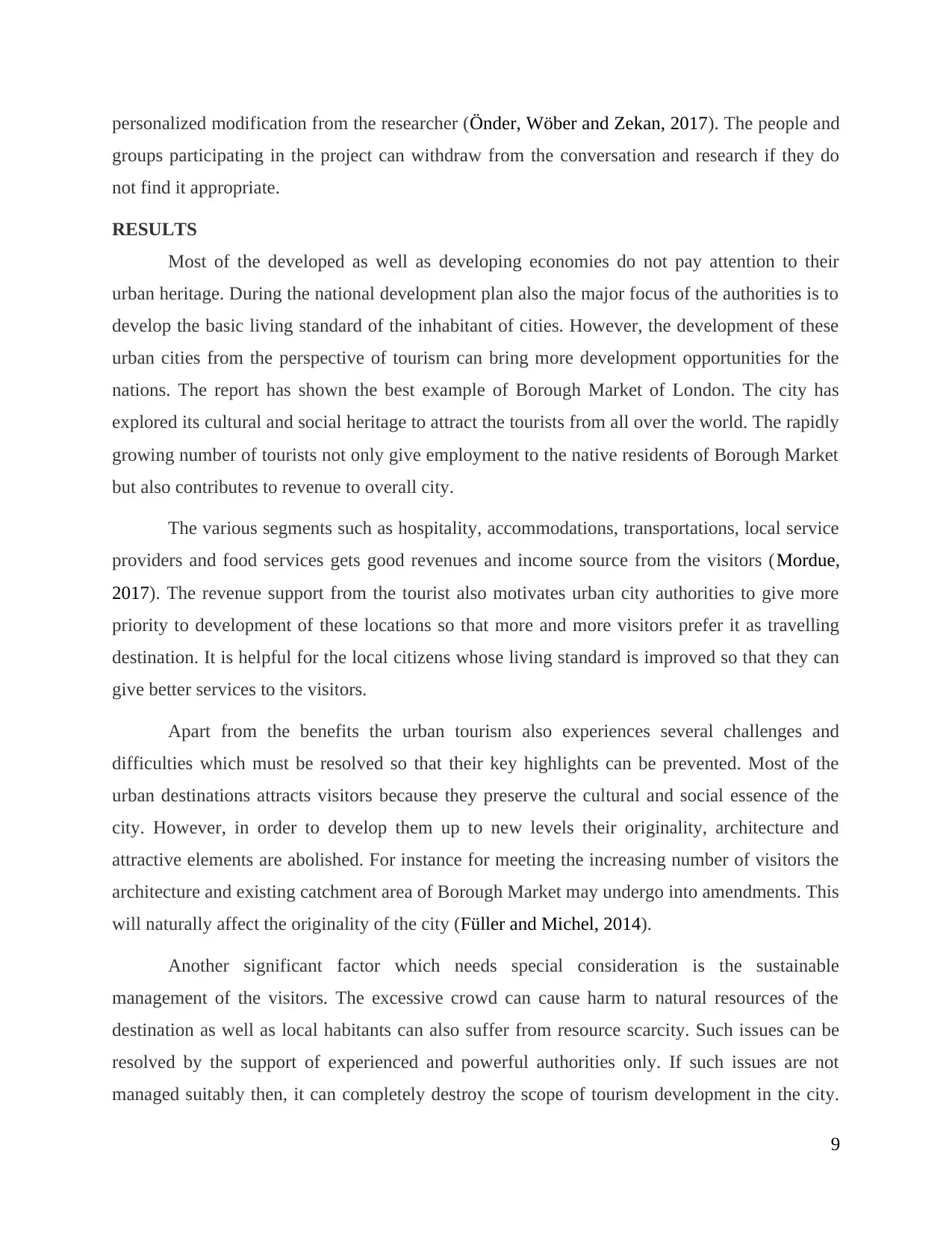
personalized modification from the researcher (Önder, Wöber and Zekan, 2017). The people and
groups participating in the project can withdraw from the conversation and research if they do
not find it appropriate.
RESULTS
Most of the developed as well as developing economies do not pay attention to their
urban heritage. During the national development plan also the major focus of the authorities is to
develop the basic living standard of the inhabitant of cities. However, the development of these
urban cities from the perspective of tourism can bring more development opportunities for the
nations. The report has shown the best example of Borough Market of London. The city has
explored its cultural and social heritage to attract the tourists from all over the world. The rapidly
growing number of tourists not only give employment to the native residents of Borough Market
but also contributes to revenue to overall city.
The various segments such as hospitality, accommodations, transportations, local service
providers and food services gets good revenues and income source from the visitors (Mordue,
2017). The revenue support from the tourist also motivates urban city authorities to give more
priority to development of these locations so that more and more visitors prefer it as travelling
destination. It is helpful for the local citizens whose living standard is improved so that they can
give better services to the visitors.
Apart from the benefits the urban tourism also experiences several challenges and
difficulties which must be resolved so that their key highlights can be prevented. Most of the
urban destinations attracts visitors because they preserve the cultural and social essence of the
city. However, in order to develop them up to new levels their originality, architecture and
attractive elements are abolished. For instance for meeting the increasing number of visitors the
architecture and existing catchment area of Borough Market may undergo into amendments. This
will naturally affect the originality of the city (Füller and Michel, 2014).
Another significant factor which needs special consideration is the sustainable
management of the visitors. The excessive crowd can cause harm to natural resources of the
destination as well as local habitants can also suffer from resource scarcity. Such issues can be
resolved by the support of experienced and powerful authorities only. If such issues are not
managed suitably then, it can completely destroy the scope of tourism development in the city.
9
groups participating in the project can withdraw from the conversation and research if they do
not find it appropriate.
RESULTS
Most of the developed as well as developing economies do not pay attention to their
urban heritage. During the national development plan also the major focus of the authorities is to
develop the basic living standard of the inhabitant of cities. However, the development of these
urban cities from the perspective of tourism can bring more development opportunities for the
nations. The report has shown the best example of Borough Market of London. The city has
explored its cultural and social heritage to attract the tourists from all over the world. The rapidly
growing number of tourists not only give employment to the native residents of Borough Market
but also contributes to revenue to overall city.
The various segments such as hospitality, accommodations, transportations, local service
providers and food services gets good revenues and income source from the visitors (Mordue,
2017). The revenue support from the tourist also motivates urban city authorities to give more
priority to development of these locations so that more and more visitors prefer it as travelling
destination. It is helpful for the local citizens whose living standard is improved so that they can
give better services to the visitors.
Apart from the benefits the urban tourism also experiences several challenges and
difficulties which must be resolved so that their key highlights can be prevented. Most of the
urban destinations attracts visitors because they preserve the cultural and social essence of the
city. However, in order to develop them up to new levels their originality, architecture and
attractive elements are abolished. For instance for meeting the increasing number of visitors the
architecture and existing catchment area of Borough Market may undergo into amendments. This
will naturally affect the originality of the city (Füller and Michel, 2014).
Another significant factor which needs special consideration is the sustainable
management of the visitors. The excessive crowd can cause harm to natural resources of the
destination as well as local habitants can also suffer from resource scarcity. Such issues can be
resolved by the support of experienced and powerful authorities only. If such issues are not
managed suitably then, it can completely destroy the scope of tourism development in the city.
9
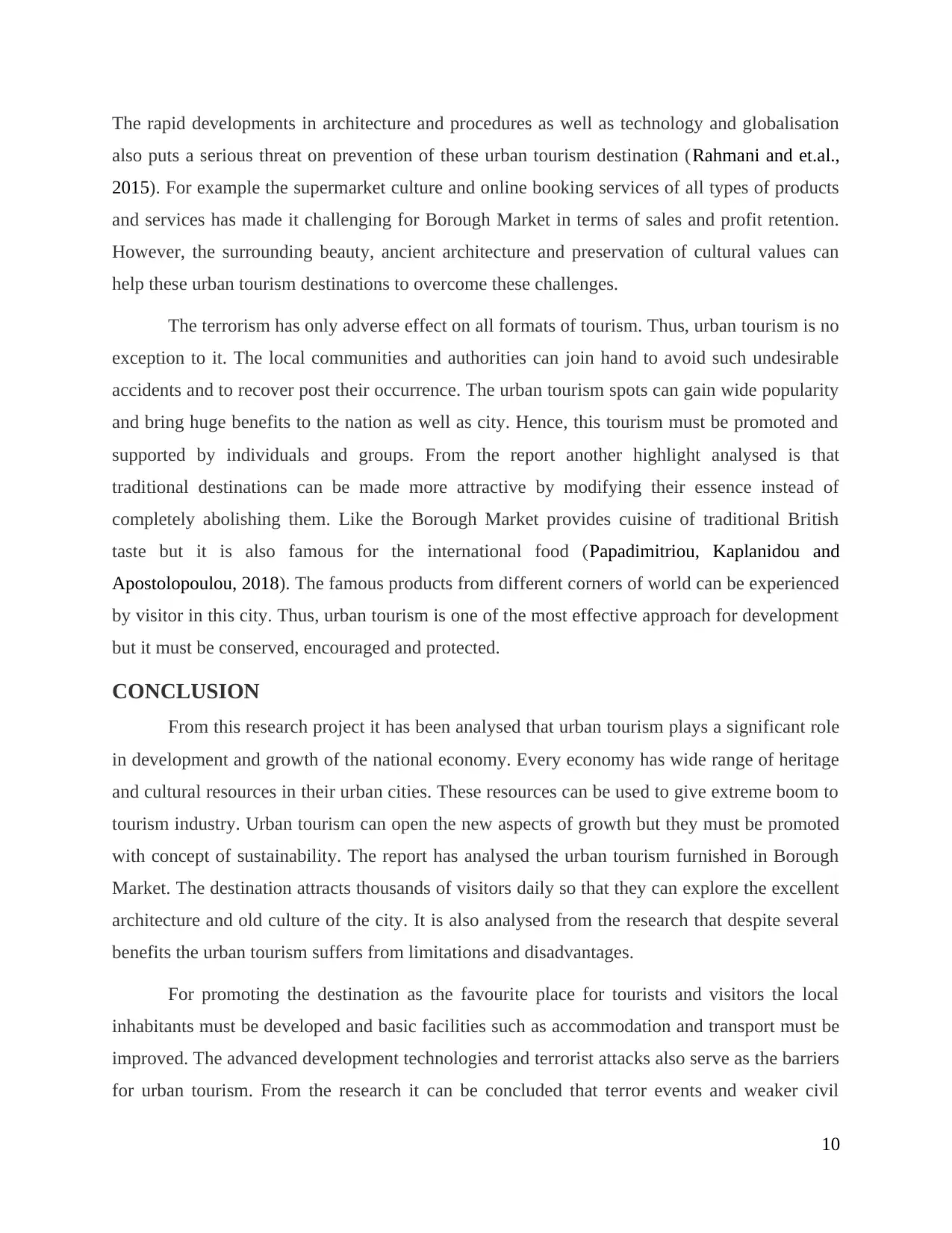
The rapid developments in architecture and procedures as well as technology and globalisation
also puts a serious threat on prevention of these urban tourism destination (Rahmani and et.al.,
2015). For example the supermarket culture and online booking services of all types of products
and services has made it challenging for Borough Market in terms of sales and profit retention.
However, the surrounding beauty, ancient architecture and preservation of cultural values can
help these urban tourism destinations to overcome these challenges.
The terrorism has only adverse effect on all formats of tourism. Thus, urban tourism is no
exception to it. The local communities and authorities can join hand to avoid such undesirable
accidents and to recover post their occurrence. The urban tourism spots can gain wide popularity
and bring huge benefits to the nation as well as city. Hence, this tourism must be promoted and
supported by individuals and groups. From the report another highlight analysed is that
traditional destinations can be made more attractive by modifying their essence instead of
completely abolishing them. Like the Borough Market provides cuisine of traditional British
taste but it is also famous for the international food (Papadimitriou, Kaplanidou and
Apostolopoulou, 2018). The famous products from different corners of world can be experienced
by visitor in this city. Thus, urban tourism is one of the most effective approach for development
but it must be conserved, encouraged and protected.
CONCLUSION
From this research project it has been analysed that urban tourism plays a significant role
in development and growth of the national economy. Every economy has wide range of heritage
and cultural resources in their urban cities. These resources can be used to give extreme boom to
tourism industry. Urban tourism can open the new aspects of growth but they must be promoted
with concept of sustainability. The report has analysed the urban tourism furnished in Borough
Market. The destination attracts thousands of visitors daily so that they can explore the excellent
architecture and old culture of the city. It is also analysed from the research that despite several
benefits the urban tourism suffers from limitations and disadvantages.
For promoting the destination as the favourite place for tourists and visitors the local
inhabitants must be developed and basic facilities such as accommodation and transport must be
improved. The advanced development technologies and terrorist attacks also serve as the barriers
for urban tourism. From the research it can be concluded that terror events and weaker civil
10
also puts a serious threat on prevention of these urban tourism destination (Rahmani and et.al.,
2015). For example the supermarket culture and online booking services of all types of products
and services has made it challenging for Borough Market in terms of sales and profit retention.
However, the surrounding beauty, ancient architecture and preservation of cultural values can
help these urban tourism destinations to overcome these challenges.
The terrorism has only adverse effect on all formats of tourism. Thus, urban tourism is no
exception to it. The local communities and authorities can join hand to avoid such undesirable
accidents and to recover post their occurrence. The urban tourism spots can gain wide popularity
and bring huge benefits to the nation as well as city. Hence, this tourism must be promoted and
supported by individuals and groups. From the report another highlight analysed is that
traditional destinations can be made more attractive by modifying their essence instead of
completely abolishing them. Like the Borough Market provides cuisine of traditional British
taste but it is also famous for the international food (Papadimitriou, Kaplanidou and
Apostolopoulou, 2018). The famous products from different corners of world can be experienced
by visitor in this city. Thus, urban tourism is one of the most effective approach for development
but it must be conserved, encouraged and protected.
CONCLUSION
From this research project it has been analysed that urban tourism plays a significant role
in development and growth of the national economy. Every economy has wide range of heritage
and cultural resources in their urban cities. These resources can be used to give extreme boom to
tourism industry. Urban tourism can open the new aspects of growth but they must be promoted
with concept of sustainability. The report has analysed the urban tourism furnished in Borough
Market. The destination attracts thousands of visitors daily so that they can explore the excellent
architecture and old culture of the city. It is also analysed from the research that despite several
benefits the urban tourism suffers from limitations and disadvantages.
For promoting the destination as the favourite place for tourists and visitors the local
inhabitants must be developed and basic facilities such as accommodation and transport must be
improved. The advanced development technologies and terrorist attacks also serve as the barriers
for urban tourism. From the research it can be concluded that terror events and weaker civil
10
⊘ This is a preview!⊘
Do you want full access?
Subscribe today to unlock all pages.

Trusted by 1+ million students worldwide
1 out of 15
Related Documents
Your All-in-One AI-Powered Toolkit for Academic Success.
+13062052269
info@desklib.com
Available 24*7 on WhatsApp / Email
![[object Object]](/_next/static/media/star-bottom.7253800d.svg)
Unlock your academic potential
Copyright © 2020–2025 A2Z Services. All Rights Reserved. Developed and managed by ZUCOL.





